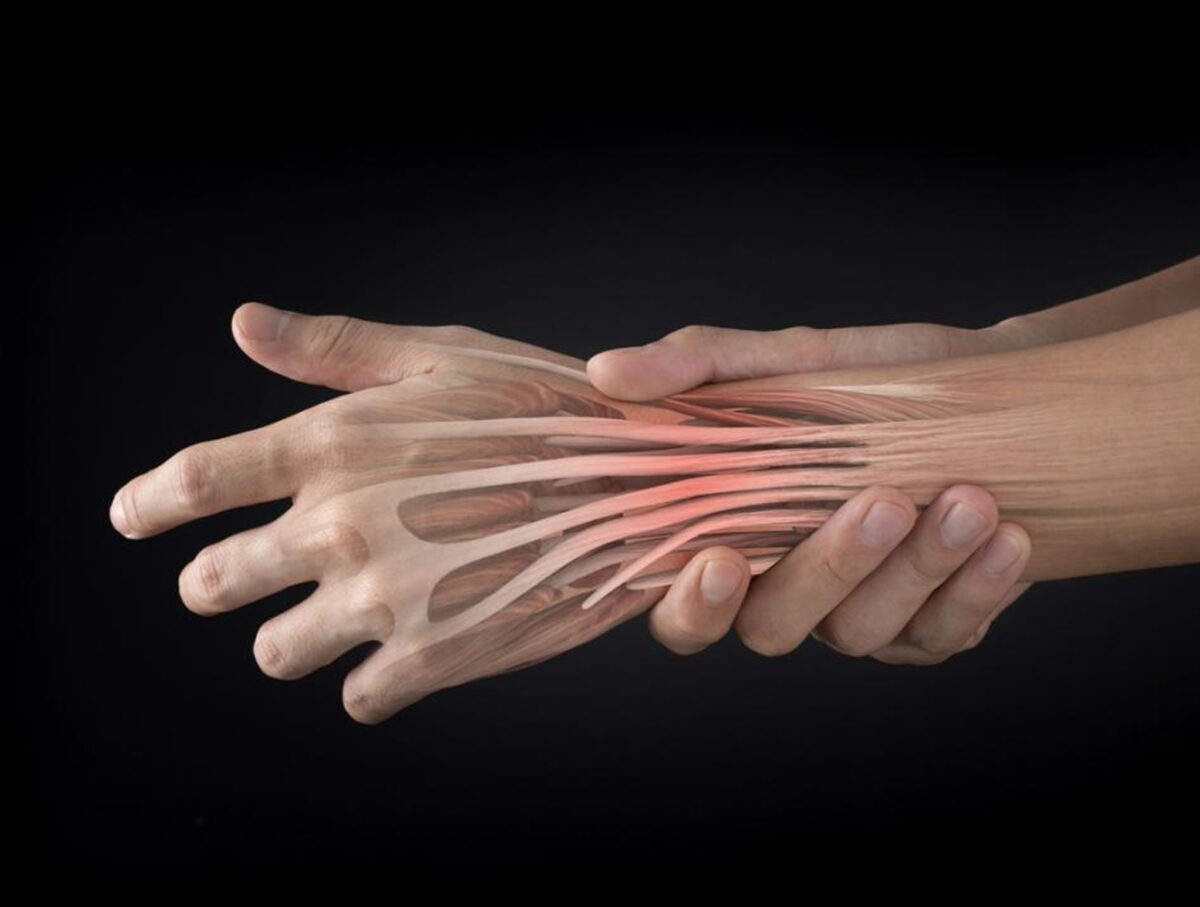Diagnosis: PANDEMIC TENDONITIS

This article was originally published to The ASHT Times – The Newsletter of The American Society of Hand Therapists
View the print version of this publication here
By Chaya Schachter, OTR/L, CHT; Kim Conti, OTR, CHT; and Alexander Marcus, MD
As occupational, physical and hand therapists, our role during the pandemic requires us to adapt to the changes around us. Initially, a key concern was learning and implementing telehealth services. To date, parts of the country that are returning from lockdown have shifted their focus towards the consequences of the shelter-in-place orders. As a consequence of the COVI D-19 pandemic, more workers than ever are working from home1 where the ergonomics may be sub-optimal. Anecdotal reports have hinted at recent job changes and adjustments of work contexts and tasks. Looking further down the road, people and companies may realize the advantages of working from home and learn ways to overcome some of the barriers to having a distributed workforce.’ As a result, more people may be working from home indefinitely.
Over the last few months, hand surgeons and therapists have been seeing patients suffering from some of the ill effects of this new normal. A common phenomenon and a steady trend we have been witnessing is various complaints of (usually) nonspecific elbow, wrist and digital pain or paresthesia. Although a proven causative relationship between a work-from-home setting as it relates to poor workstation design, ergonomic pitfalls and work-related musculoskeletal disorders has not been definitively determined, many patients are presenting with these symptoms.
Our objective is to highlight and underscore the importance of effective information gathering and history taking.
Case Report
Presentation
A 52-year-old healthy math teacher presented with bilateral dorsal wrist pain for six weeks. There was no history of trauma, infection nor other symptoms. His exam was unremarkable except for pain with wrist flex ion and extension as well as tenderness over the fourth extensor compartment. His x-rays were normal.
Upon further questioning, his school building had closed because of COVID-19 eight weeks prior to his visit. Instead of teaching in front of a classroom, writing on the board, and moving around to observe students’ work, he was now teaching all his lessons from his home computer. He used his personal laptop positioned on the coffee table in front of his couch. All his communication with students, parents and co-workers was by email. His total workday was seven hours, with a 30-minute lunch break.
Diagnosis
Pandemic Tendonitis – tendonitis coused or exocerboted by new working conditions resulting from the COVID-19 pandemic.
Discussion
We are experienced in evaluating and teaching patients about ergonomics. Now, during this unprecedented time, we need be aware of the new challenges our patients face and to improve our history gathering and intake as it relates to ergonomic challenges and risks. This heightened awareness will allow us to better understand and treat this growing sector of the work force.
Asking the right questions
An increased recognition of these developments will enable us to ask important questions, including inquiries about specific situations that can exacerbate tendonitis (i.e., secondary factors such as increased workload, pressure and stress due to recent furloughs and layoffs). For example, an answer of yes to a question such as, “Has your work environment changed?” would then lead us to ask:
Where are you and your computer situated?
Often the at-home work environment causes us to use whatever is available. Despite setting up a workstation replete with a proper desk, chair and monitor, the dynamic duties at home may interfere with a static workstation design. Are you working at the kitchen table? A kitchen table is designed to be used for meals, but the height relative to the chairs is sub-optimal for typing. Are you working on the couch while watching the kids? Although comfortable, one can easily assume the “tech neck” posture (descriptive terminology coined to describe general postural compromise). A couch is not designed to sit on while typing for several hours.’ Are you doing a significant proportion of your work, especially elements that involve significant typing, on a phone, tablet or other handheld device?
Is your work setup dictated by other factors?
The pandemic has altered many components of home life. If children are now at home full time, office work may be done wherever the kids are so that they can be supervised simultaneously. The playroom may not be conducive for proper typing ergonomics, and other responsibilities may dictate where work is done. Have you resorted to typing while standing at a kitchen counter to juggle dinner preparation and writing a work report?
Are you taking fewer breaks?
In an office environment, people often move around to verbally communicate with colleagues. Now with people in their own homes, communication often takes place via email. Instead of walking over to your co· worker’s desk to ask ifs/he got the file you emailed, you just type another email to ask him or her. At the office, people leave their desks and computers to go to meetings. With everyone working remotely, meetings often occur via Zoom (or other platforms) while sitting at the computer.
Does your job involve light lifting or assembly?
While many of the issues affecting wrist tendonitis involve typing at a computer, other workers may be lifting files or assembling packages that are stored on the floor instead of in a waist-high file cabinet or table.
Did you have ergonomic devices in the office that you do not have at home?
Many people have an ergonomic keyboard or mouse at the office but not at home. A telephone headset may allow you to sit properly while working at your desk but juggling your cellphone while typing at your laptop may not.
Are you doing the same job or has your job changed?
Many people have been furloughed during the economic downturn and forced to change jobs. Had you previously been sitting at a computer all day, but are now doing physical labor for the first time in many years? Were you working outside or traveling between customers, but now only sitting at a desk?
If you are still working in the company office, has the setup changed?
Even if you are still going to the office or plant, your desk or workstation that was optimized for your job specifications may have changed because of new social distancing requirements. Is your workplace implementing a staggered return? If so, will you be able to re-occupy your station and use your worker-specific equipment in this fluid design?
Getting More Information
Some patients may not be able to describe their work environment in a way that allows us to help them efficiently. Taking pictures is one way for patients to share this information, but only if they know how to best photograph their work location. There are new smartphone apps such as Ergoconnect that guide users on best methods to photograph a workstation in the most informative way (i.e., static positioning [side view, leg clearance] and whilst performing activities [using phone, mouse, keyboard]). Others, for example, include Ergominder and StretchMinder whose key feature is to remind the user to perform stretches throughout the day. Wellnomics and Healthworking are additional apps available with well-designed, user-friend( y videos of various stretches of the body. Workrave is a program for your PC designed to offer rest periods and screen time limits to prevent repetitive strain injury. (Editors note: No conflict of interest.)
Educating Our Patients
Our experience includes teaching patients how to optimize their work environment. Our role remains the same in regards to patient education, determining aggravating factors and outlining ergonomic changes. There is a continued need to mitigate primary factors that are thought to trigger musculoskeletal disorders, such as excessive force, repetitive movements and harmful body postures. Research has shown that sustained postures or repetitive motion causes ischemic injuries, leading to tissue damage. We routinely discuss chair and desk heights, viewing distance of computer monitors, maintaining a 90-degree angle at the ankles/knees/hips/elbows, as well as encouraging rest breaks and performing various stretches.
Utilization of ergonomic equipment is important to consider, such as a split keyboard design to decrease excessive ulnar deviation and compression of the ulnar nerve. Use of a vertical mouse can lessen forearm pronation and decreases stress and compression of the radial and median nerves. Placing a pen beneath the index finger to create MP joint hyperextension or wearing a yoke splint while typing can offload the radial nerve at the wrist. Posture rebalancing with the use of a figure eight strap can assist with scapular and core retraining. Educating our patients in joint protection, typing postures and the need to strengthen proximal muscles should also be reinforced.
Looking Forward
This time of unusual challenge has led to many changes in how and where people work. Some of these changes will lead to wrist and hand issues. As practitioners, we need to revolutionize our thinking as it relates to ergonomic shortcomings which should be reflected in our history taking. Our pattern of thinking needs to shift to encompass fluid and dynamic home ergonomic set ups, workstation design changes, environmental barriers, constant interruptions and increased overall stress.
We can better serve our patients by changing our line of questioning during the history intake. This shift can help to mitigate patient symptoms using appropriate ergonomic education and therapeutic interventions. Helping patients adapt to their new environment will ultimately reduce the need for unnecessary tests and treatments, thereby creating a more favorable outcome. Since we need to grapple with a fluid workstation, we must shift our emphasis from the recommendation of ergonomic devices and instead work with our patients in mitigating poor work styles and habits (i.e., controlling neck, back and wrist positioning, using keyboard shortcuts).
The shift to work from home has been long in coming but the pandemic has expedited this transformation. In instances where employers were afraid to embrace this change, the widespread state lockdowns had an enormous effect on workplace trends that, in some shape or form. may remain permanent.’ For the remote employee population, the ease of abandoning the home office and, instead, switching to a mobile device while completing household duties may seem like an added efficiency in one’s day; however, the pitfalls of a relaxed posture combined with surrounding, hectic calls of duty and high responsibility at work can eventually morph into a repetitive strain injury. For us practitioners, we need to educate and bring awareness to the consequences of our new reality.
Notes
- In an article written by Susan Ward and published online in September, 2019, titled “Disadvantages of Working From Home”, 25% of those surveyed reported a lack of proper work surface and 23% reported bad posture.
- An early survey (administered and analyzed in combination by lometrics and Global Workplace Analytics) collected results from approximately 3,000 employees globally who responded to a survey between 3/30/2020 and 4/24/2020. The “Global Work-fromHome-Experience Survey” discovered that 88%of office workers are working from home, and 77% of employees wish to continue working from home at least once a week.
- In an online article titled. “The Workplace Revolution – a Picture of Flexible Working.” information was extracted from an online survey during 2016 from 20,000 business respondents from more than 100 countries. It has become apparent, even prior to the pandemic, that the shift towards working from home has become widespread and prevalent.
